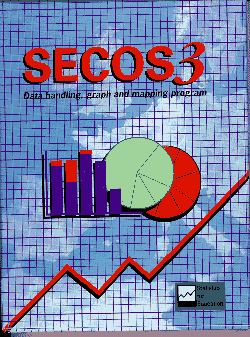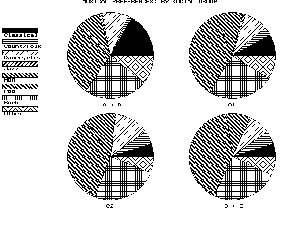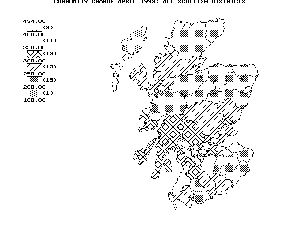Volume 9, Issue 2, 1995

SECOS-3: Data Handling, Graph and Mapping Program
SECOS-3 is the latest release of the data investigation program from Statistics for Education, the earlier release of which was reviewed by Guy Judge in CHEER No. 13. The new release sees the program's continued evolution with the introduction of many new and innovative features while retaining the user friendliness of the earlier release. More important, the number of published datasets and student investigations has also grown since the previous review, and the creation of new datasets is now more straightforward. Consequently, the attraction of the program has increased significantly.The program, which runs on any PC compatible, comes on a single 3«" disk (which includes a demonstration dataset). A further disk holds the map files. The accompanying manual is comprehensive and well written, and instructors are free under the terms of the licence to reproduce and distribute documentation within the holding institution. Installation was quick and straightforward. Those wishing to examine the program before committing either themselves or their institution to purchasing a copy can obtain a fully working demonstration disk from the publishers free of charge. The package is competitively priced for HE institutions at £80 for a single user licence and £250 for a site licence (25 machines, plus £5 for each additional machine). Site licences for the datasets are priced at £35 (single user) and £70 (site licence).
For those unfamiliar with SECOS, it can best be described as a cross between a database and a spreadsheet, combining the appeal of both without the high investment in time required to use standard commercial products. Using the program with the available datasets allows users with little or no formal knowledge of computing or statistical theory to manipulate, analyse and graph data by following easy to understand menu commands. The publishers rightly claim that students can achieve meaningful results within an hour of using the program, which is definitely not the case with most business software. While it lacks the flexibility, power and sophistication of the programs I currently use for teaching (QPro and Paradox), it is certainly less intimidating for those encountering data analysis for the first time.
Given that SECOS is already widely used and has been previously reviewed in CHEER, I shall concentrate upon the features of the latest release that are likely to be of interest to existing users. First, it is comforting to note that the `look and feel' of the program remains unchanged. Datasets, which retain their quasi-spreadsheet appearance on-screen, are still accessed by browsing book-style `chapter and subheadings', while menus are activated using a simple combination of function and cursor keys. An initial indication of the overall improvement to the program can be gained by turning to the help menus, replicating the text from the extensive and useful manual. Important as these changes are, I was most interested to see what additional facilities for analysing, graphing and exchanging data SECOS-3 offered. In my opinion, the latest release is a substantial improvement on the earlier product.
The value of this program lies in its ability to enable students to undertake data analysis using simple menu commands. While the earlier release was simple to use, the restricted range of commands for transforming and analysing data limited its value to the HE sector. Therefore, it is pleasing to note that the new release is more powerful and sophisticated while retaining an easy-to-use approach. The Calc. sub-menu (activated by the [F4] key) offers a similar range of options as the previous version (indices, growth rates, averages, etc.), but now offers an extended series of functions through further sub-menus. Among the more important new options are the tools for calculating trends (OLS regression, moving averages, exponential smoothing), first differences (expressed either in absolute terms or as percentages), squares and square roots. Moreover, it is now possible to express data as logarithms, and limited procedures for dealing with missing observations are also available. These additional features should greatly enhance the program's value to the HE community, not only because these are standard methods taught early in most undergraduate economics and related courses, but because they make the program suitable as a primer for more sophisticated packages such as SPSS.
Evidence of substantial improvement is also noticeable in the graphics submenu in terms of the range of graph types available and the degree to which they can be manipulated. Pie charts and `magic squares' (as developed by Nicholas Kaldor) have been added to the basic line/bar and scatter graphs previously on offer. As can be seen from Figure 1, it is possible to create multiple pie charts, a feature that also applies to the magic squares. While this feature is hardly unique to SECOS-3, I would point out that this was achieved with far less effort than with my current spreadsheet. Graphs can be manipulated extensively when in full-screen mode and, unlike the previous version, previewed before printing and saved as PCX files.
 Figure 1: Multiple Pie Charts
Figure 1: Multiple Pie Charts
 Figure 2: An Example of SECOS 3's Mapping facilities
Figure 2: An Example of SECOS 3's Mapping facilities
- Nuffield Economics & Business Investigations - drawing upon data made available from the Nuffield Foundation;
- World Trends - using World Bank data;
- UK Business Trends - adapted from the CSO Monthly Digest of Statistics and Economic Trends Annual Supplement;
- British Historical Statistics - adapted from B.R. Mitchell's British Historical Statistics, CUP, 1988.
Each dataset is accompanied by a manual of student investigations that provide accurate commands for students to enable students to explore data. Having worked through several exercises, I can confirm that they are carefully and intelligently written, embodying a range of challenging and provoking lines of enquiry. Furthermore, the diversity of the investigations now available should ensure that they find a niche beyond introductory data analysis courses; I could contemplate, for example, students taking a course in industrial/managerial economics benefitting from examining product life cycles in the recorded music market, or students taking development economics options profiting from the World Trends investigations. A further valuable point to note is that the written study materials provide a helpful guide for instructors wishing to develop their own course materials using some more advanced statistical methods. Closer to home, I have found the British Historical Statistics dataset especially useful as a reference work for teaching and research.
In conclusion, I would recommend SECOS-3 as a valuable tool for economics education; it is cheap, flexible and easy-to-use. Interesting and informative data investigations are available that should satisfy a variety of needs. While it lacks the power and grace of many modern commercial programs, it is designed to relieve students of the responsibility of using the package and concentrate upon the real task at hand, analysing data. While it is a serious educational tool, it is also fun to use. I regard it as a valuable aid to enhance students confidence in handling data during the early stages of their formal training. Once students have familiarised themselves with the software there is no reason why many investigations cannot be integrated into many areas of undergraduate teaching. Overall, I would continue to endorse Guy's earlier recommendation: "everyone should have it".
Chris Reid
University of Portsmouth
Contact: Statistics for Education, 5 Bridge Street, Bishop's Stortford, Herts., UK, CM23 2JU Tel: 01279 652183
REFERENCES
- Judge, G., "SECOS and EURECO", CHEER, No. 13, 1991, pp. 31-34

